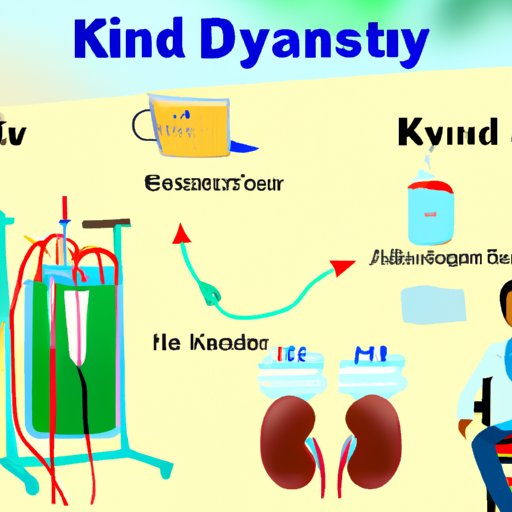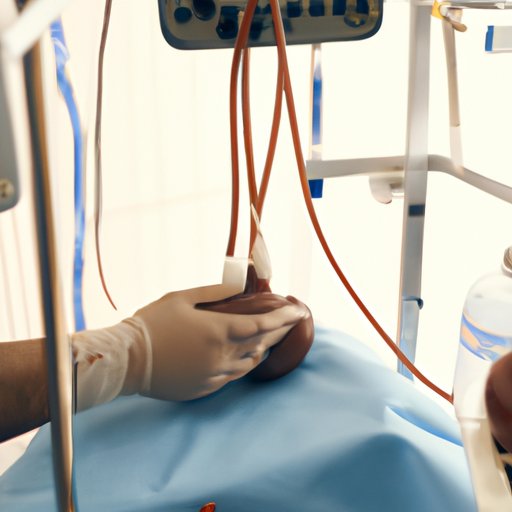Introduction
Dialysis is a medical procedure used to treat people with kidney failure. When the kidneys are unable to perform their normal functions, such as filtering out waste and toxins from the body, dialysis can be used to do this job instead. Dialysis is an important treatment for those with chronic kidney disease, but it is also used in emergency situations when the kidneys are suddenly not able to function properly.
Explaining Dialysis: A Step-by-Step Guide
To understand how dialysis works, it’s important to first look at what it is and how it works. Dialysis is a medical procedure that uses a machine to filter the blood and remove excess fluid and waste. The process involves passing the patient’s blood through a semi-permeable membrane, which acts as a filter. The membrane allows small molecules, such as electrolytes, to pass through while blocking larger molecules, such as proteins and cells. The filtered blood is then returned to the patient’s body.
The Science Behind Dialysis
The science behind dialysis is complex, but essentially it works by using osmosis and diffusion to move substances across a semi-permeable membrane. Osmosis is the process by which water moves through a membrane in response to a concentration gradient, while diffusion is the process by which molecules move from an area of higher concentration to one of lower concentration. In dialysis, the semi-permeable membrane separates the blood into two compartments, allowing for the movement of certain molecules between them.
An Overview of the Different Types of Dialysis
There are two main types of dialysis: hemodialysis and peritoneal dialysis. Hemodialysis is the most common type and involves using a machine to filter the blood. Peritoneal dialysis involves using the patient’s own peritoneal membrane to filter the blood. Both types of dialysis can be done either in-center or at home.
Understanding the Process of Dialysis
Once the type of dialysis has been determined, the next step is to understand the process of dialysis itself. During hemodialysis, the patient’s blood is drawn from their arm and passed through the dialysis machine. The machine filters out the waste and excess fluid, returning the clean blood back to the patient’s body. During peritoneal dialysis, the patient’s peritoneal membrane is used to filter the blood. The membrane is filled with a special solution that absorbs the waste and excess fluid from the blood, which is then removed from the body.
The Role of Diet and Medication
In addition to the dialysis procedure, patients may need to make dietary changes to ensure they are getting enough nutrients. They may also need to take medication to help regulate their body’s processes and to prevent complications. It is important for patients to follow their doctor’s advice and to work with their healthcare team to develop an individualized plan that meets their needs.

How Dialysis Helps People with Kidney Disease
Dialysis is an important treatment for those with chronic kidney disease, as it can help to extend life expectancy and improve quality of life. Dialysis helps to filter out waste and excess fluid from the body, which can reduce symptoms and prevent complications. It can also help to reduce high levels of potassium in the blood, which can be dangerous.
Benefits of Dialysis
According to a study published in the Clinical Journal of the American Society of Nephrology, dialysis can provide numerous benefits for patients with kidney disease including improved energy levels, reduced swelling and itching, improved appetite and weight gain, reduced risk of infection, and improved mental health and well-being. Additionally, dialysis can help to reduce high levels of potassium in the blood and can help to reduce the risk of heart attack, stroke, and other complications.
Risks Associated with Dialysis
As with any medical procedure, there are risks associated with dialysis. Possible complications include infection, bleeding, low blood pressure, and allergic reactions. Additionally, long-term use of dialysis can cause muscle cramps, fatigue, headaches, and nausea. It is important for patients to talk to their doctor about the potential risks and to make sure they are aware of any possible side effects.
Conclusion
Dialysis is an important medical procedure used to treat people with kidney failure. Understanding the science behind dialysis and the process of the procedure can help patients to better understand how it works and how it can help them. With proper care and management, dialysis can provide numerous benefits and can help to extend life expectancy and improve quality of life.
For those considering dialysis, it is important to talk to your doctor and to understand the risks and benefits. Additionally, it is important to follow a healthy diet and to take medications as prescribed. Finally, it is important to find support and resources to help manage the condition and to ensure you are taking the best possible care of yourself.
Summary
Dialysis is a medical procedure used to treat people with kidney failure. The process involves passing the patient’s blood through a semi-permeable membrane, which acts as a filter. There are two main types of dialysis – hemodialysis and peritoneal dialysis – and both types can be done either in-center or at home. Dialysis can provide numerous benefits for patients with kidney disease, including improved energy levels, reduced swelling and itching, improved appetite and weight gain, and reduced risk of infection. However, there are risks associated with dialysis and it is important to understand these before beginning treatment.
(Note: Is this article not meeting your expectations? Do you have knowledge or insights to share? Unlock new opportunities and expand your reach by joining our authors team. Click Registration to join us and share your expertise with our readers.)
